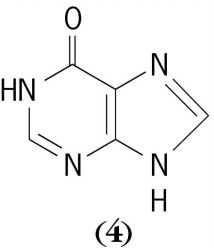Purine
A heterocyclic organic compound ( 1 ) containing
fused pyrimidine and imidazole rings. A number of substituted purine derivatives occur in nature; some, as components of nucleic acids and coenzymes, play vital roles in the genetic and metabolic processes of all living organisms. See Coenzyme, Nucleic acidPurines are generally white solids of amphoteric character. They can form salts with both acids and bases. Conjugated double bonds in purines results in aromatic chemical properties, that confers considerable stability, and accounts for their strong ultraviolet absorption spectra. With the exception of the parent compound, most substituted purines have low solubilities in water and organic solvents.
The purine bases, adenine ( 2 ) and guanine ( 3 ),
together with pyrimidines, are fundamental components of all nucleic acids. Certain methylated derivatives of adenine and guanine are also present in some nucleic acids in low amounts. In biological systems, hypoxanthine ( 4 ), adenine, and guanine occur mainly as their 9-glycosides, the sugar being either ribose or 2-deoxyribose. Such compounds are termed nucleosides generically, and inosine (hypoxanthine nucleoside), adenosine, or guanosine specifically. The principal nucleotides contain 5′-phosphate groups, as in guanosine 5′-phosphate (GTP) and adenosine 5′-triphosphate (ATP).Most living organisms are capable of synthesizing purine compounds. The sequence of enzymatic reactions by which the initial purine product, inosine 5′-phosphate, is formed utilizes glycine, carbon dioxide, formic acid, and amino groups derived from glutamine and aspartic acid. Adenosine 5′-phosphate and guanosine 5′-phosphate are formed from inosine 5′-phosphate.
Metabolic degradation of purine derivatives may also occur by hydrolysis of nucleotides and nucleosides to the related free bases. Deamination of adenine and guanine produces hypoxanthine and xanthine ( 5 ), both of which may be oxidized to uric acid ( 6 ).
See Uric acidPurine-related compounds have been investigated as potential chemotherapeutic agents. In particular, 6-mercaptopurine, in the form of its nucleoside phosphate, inhibits several enzymes required for synthesis of adenosine and guanosine nucleotides, and thus proves useful in selectively arresting the growth of tumors. The pyrazolopyrimidine has been used in gout therapy. As a purine analog, this agent serves to block the biosynthesis of inosine phosphate, as well as the oxidation of hypoxanthine and xanthine to uric acid. As a result of its use, overproduction of uric acid is prevented and the primary cause of gout is removed. See Chemotherapy, Pyrimidine



